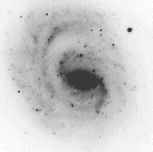Many galaxies show evidence for lopsidedness either in their optical light or HI distribution. For his Ph.D. thesis, Dave Kornreich analyzed deviations from morphological and kinematic axisymmetry in a sample of face-on spiral galaxies. He developed a photometric method of quantifying morphological asymmetry that compares the relative fluxes contained within trapezoidal sectors arranged symmetrically about the galaxy center of light, excluding the bulge and/or barred regions. Four quantitative measures of dynamical nonaxisymmetry are then compared to one another and to the quantitative measures of morphological asymmetry in HI maps and R-band images to investigate the relationships between nonaxisymmetric morphology and dynamics.
These asymmetry measures were applied also to Katie Jore's sample of morphologically normal but kinematically decoupled Sa disks. For these objects, a relationship between rotation curve asymmetry and the kinematic n=2 mode was found. Furthermore, the warps observed in the HI disks of these galaxies deviate significantly from the simple rules for warps that commonly appl. We find no significant relationship between asymmetric morphology and most of the dynamical measures in our sample. A possible relationship is found, however, between morphology and dynamical position angle differences between approaching and receding sides of the galaxy. Dave also performed a computer simulation of librational motion in galaxies to test the hypothesis that free libration of disks within dark halos contributes to nonaxisymmetries in isolated galaxies.Related Publications
